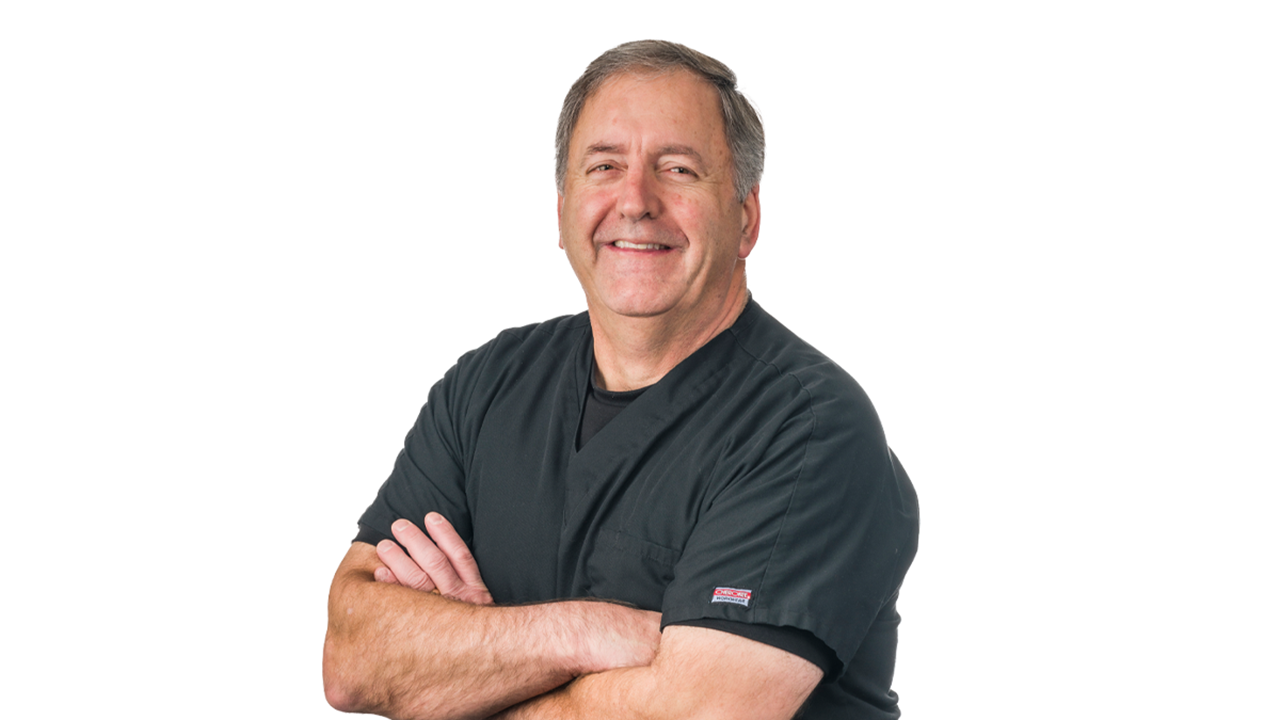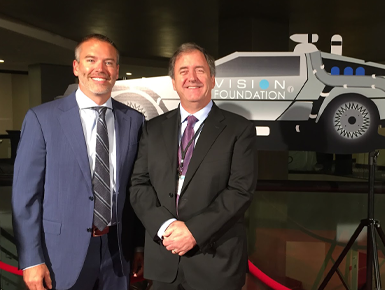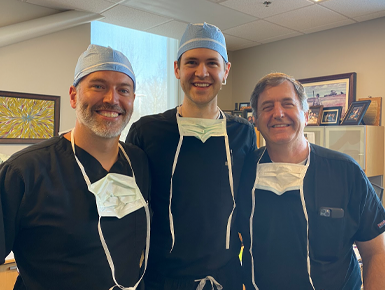Driven to Serve: Alumnus Vance Thompson Delivers Compassionate Eye Care

Now internationally recognized, Thompson has performed over 100,000 eye surgeries and has been a principal investigator in over 100 FDA-monitored clinical trials on advanced surgery.
His practice – Vance Thompson Vision, which he founded in Sioux Falls – has grown to seven practices in six states spanning the upper Midwest.
With these impressive achievements to his name, Thompson, who grew up in Gregory, South Dakota, attributes his success to his call to serve and make people happy.
“I’m a natural helper; driven to serve,” said Thompson, whose father and grandfather were physicians in rural South Dakota.
Following in his family’s footsteps, Thompson attended USD with intentions to go to medical school to become a family physician.
“Coming from a small town in South Dakota, I was intimidated by going to college, but USD was the right size of town for me and the right size of school,” he said. “I had to work hard, but that hard work culminated in getting the acceptance letter from the USD medical school. I’ll never forget that feeling.”
After earning his Doctor of Medicine in 1986, Thompson went on to an ophthalmology residency at the University of Missouri, followed by a cataract and refractive surgery fellowship at Hunkeler Eye Clinic in Kansas City, Missouri.
Though he could have gone anywhere in the world, Thompson returned to his beloved home state of South Dakota to start his business where he gets to make people happy every day.
Not far from his alma mater, Thompson now serves as a professor of ophthalmology in the USD Sanford School of Medicine, preparing the next generation of doctors.
We asked Thompson about his time at USD, his work as one of the leading specialists in refractive and cataract surgery, and much more. Here’s what he had to say.
What was life at USD like for you?
When I was at USD, I studied hard because I was a pre-medical student, but I really wanted to get involved in leadership. I also loved all the activities on campus and participated whenever I could. I was in the Greek system, and I was interfraternity council president. The advisor was Nancy McCahren; she was amazing.
Do you remember a class that was particularly impactful?
One of the most impactful classes was organic chemistry. Everyone is intimidated by organic chemistry: It’s not easy, and it’s often a defining moment for many pre-medical students. But the professor, Dr. Stoner, had an amazing reputation for being a quality instructor, and he would meet with me whenever I needed, away from class. He was patient. That class was really pivotal for me. It made me feel confident that I had what it took to get into medical school.
What’s one of your favorite memories from your time at USD?
My favorite memory at USD was when I saw this girl escorting Miss South Dakota in the Dakota Days parade. There was something really special about her. I was interfraternity council president at the time, and as I went through the parade, I couldn’t stop thinking about her. That evening, I had the pleasure of meeting Jana Kapaska ’83. She’s been my wife ever since those days at USD.
What advice do you have for recent graduates?
Have the confidence to do whatever your heart desires. I really believe in chasing your dreams. I’m convinced that in order to be excellent at something, you need to enjoy it. I would tell new graduates not to see any barriers in chasing their dreams.
How do you stay connected to USD?
I stay connected to USD through my friends, my Sigma Alpha Epsilon fraternity, and of course, through events like Dakota Days. I stay connected to the medical school, too, and have been on its admissions committee. I really enjoyed that. I also love it when our pre-medical students come through our eye surgery center. It’s rewarding to teach and talk with them about their journey and what they’re interested in.
I have also had the honor of getting to know President Sheila Gestring. It has really meant a lot to me to have a leader who is so accessible to the alumni community and who enjoys the alumni community.
I feel a real closeness to the university.
Why do you choose to invest in USD?
What USD did for me was so pivotal in my life. If I had gone to another college, I don’t know if I would have grown in the same way I did or achieved what I have achieved.
I felt like there was a personal interest in me and like it was an atmosphere that allowed me to figure out who I was. I would highly recommend this university to anyone in the world to come to for this pivotal part of their life.
What is happening now at USD that excites you?
I am a believer in progress. Innovation and keeping up with change are so important to any business. The same goes for USD. It excites me to see such a strong alumni community willing to invest in their institution and pay it forward.
How did you get into vision correction and LASIK?

The laser vision research went very well, and there were just a few centers in the world that had performed the research. When I returned to South Dakota, I was offered to be one of the beginning laser vision correction centers in the world to operate with the same laser on people who could see with glasses and were blurry without them but wanted to see clearly without them. It was very expensive to fund the research, but the Sioux Valley Hospital – now Sanford Health – board of directors invited me to present my research opportunity – which I couldn’t afford – and they voted to fund my entire research project. That support and the beginning research of laser vision correction literally was rocket fuel to my career.
It amazes how this state takes care of and supports its own. The state’s support put me on the map in the world of vision correction research, and that has led to 105 clinical trials and new laser and implant vision technology studies in our country.
And it all started at USD.
Why South Dakota?
Some of the reasons why I love it here are very explainable and some of them are not. I’ll start with the ones that are tough to explain. When I’m out on the Plains of this state, there’s something that speaks to me. It’s a spiritual connection. If I ignored that connection and chose to live somewhere else, I don’t think I’d feel as complete as I do. Now for what I can explain – I love, love, love the people of this state.
I knew I wanted my life here since the eighth grade, and the state didn’t let me down. It ended up being a very fulfilling life and journey here and an amazing place to raise our children and now grandchildren.
Can you tell us about the unique landscape of South Dakota and why it’s important for people in rural areas to have access to health care?
One of the most wonderful things about our state is that we have both rural and urban settings. I feel like the rural setting is what defines our personality; it’s what makes us unique. I love the cities – I live in Sioux Falls – but I go back to my small town all the time because I want to stay in touch. I could go on and on about what I love about this state, but I do think the rural community is one of my favorite aspects of South Dakota.
As a result of our state being influenced by the rural setting, it’s important to take care of the people. Health care is absolutely critical if you’re going to have a healthy community. It’s wonderful to have the Sanford School of Medicine in our state, ensuring that rural South Dakota is well served. If a student is going to be trained to be a physician, and they happen to be able to get the degree in their home state, there’s a likelihood they will go back to their home community and in turn, better the community.
Can you explain the importance of kindness in health care?

People don’t thank me for my thousand hertz femtosecond laser that is on the cutting edge of LASIK eye surgery. They thank me for how we made them feel. At the foundation of our culture is kindness and caring.
What is your ‘why?’
My ‘why’ is to make people deeply happy. I love serving others. Even as I look at the other occupations I have had in life – I was a waiter, bartender, an orderly in a nursing home and an orderly in the hospital – everything I’ve ever done is take care of other people. And that’s what I do now. I love being a physician. I love being a surgeon. I love being a caregiver.
I’m driven to serve. My ‘why’ is to make those I serve happy.



